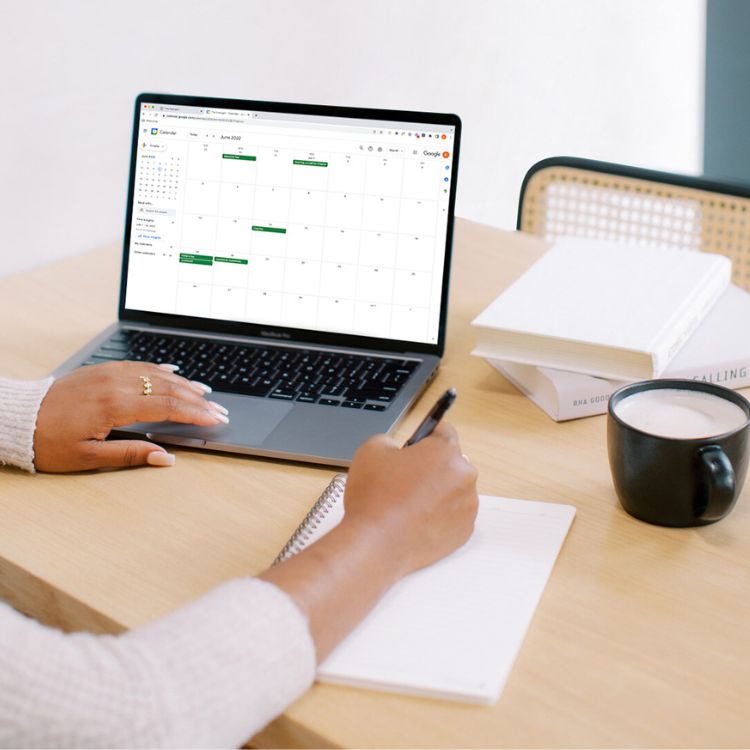
At the end of 2021, I knew it was time for me to make a change. As an entrepreneur, I was thrilled to see my business really grow throughout the year, but by the end of the year, the burnout was creeping in big time. Over the holidays I sat down and made a plan to better tackle my work days. That way, I could keep up my current output while also regaining some much-needed work-life balance. After giving a lot of different productivity methods some serious thought, I turned to time blocking and it made a world of difference in how I plan my days, how quickly I can complete tasks, and how much free time I have outside of work.
Basically—I am a time-blocking convert, so I’m here to walk you through why so many successful women swear by this productivity method and how to bring it into your own work days.
What is Time Blocking
So, what exactly is time blocking? The beauty of this productivity method is how simple it is. When you plan your workday or work week, all you have to do is divide your day into blocks of time where each block is dedicated to accomplishing either a specific task or a group of tasks. You can start by creating a normal to-do list, but then you need to take things up a notch and assign each to-do a certain block of time where you intend to complete that task.
Let’s look at an example of how I would time block my day as a writer, starting with a pretty standard to-do list.
- Write two blog posts
- Arrange three upcoming subject matter expert interviews
- Meet with two clients
- Research and outline two blog posts to write tomorrow
- Reach inbox zero
With that to-do list in mind, I would then block out my tasks around the tasks that are already set in stone (aka meetings) at certain times.
- 8-11 a.m.: Write two blog posts
- 11 a.m.-1 p.m: Meet with client #1 at 11 a.m., have lunch and take a quick walk, and meet with client #2 at 12:30 p.m.
- 1-3 p.m.: Research and outline two blog posts
- 3-4 p.m.: Arrange three subject matter expert interviews and reach inbox zero
So, how did I determine how to arrange my time blocks? To start, I am the most focused in the morning and that’s when I write best, so I chose to start my day with my biggest tasks. I had to schedule to get both of those blog posts done before meeting with my clients starting at 11 a.m. Because there was a gap between my two meetings (which makes it very easy to waste time), I scheduled my lunch break into that same block. Later in the afternoon when I have a bit less energy and focus, I decided to work on researching and outlining blog posts, which require less focus than writing. This prep work will also make it easier to jump straight into writing them the next day. I chose to then group easy and small admin tasks for the last block of the day when I find it really hard to focus on bigger projects.
How I time block might not work for you and that’s okay, but you can see from my thought process how you can use time blocking to be really strategic about how you get your work done.

Why It Works
The reason that time blocking can be so effective is that it makes it easier to commit to deep work and to make the most of your preferred working habits and schedule. Not to mention, it helps you avoid having to hem and haw over what to do once you finish a task.
When you decide on a time block and commit to it, you are dedicating yourself to one single task or a similar group of tasks which helps you devote your mental focus better. You can avoid task switching (which can really slow you down) when you group together tasks. That’s why I find it easier to send out interview requests via email in the same time block as cleaning out my inbox. The same goes for research versus writing. Research can be quite tricky and involves overcoming a lot of roadblocks and problem solving, which can be really frustrating. Grouping all of my research together makes it possible to just focus on the writing which requires deep work that isn’t slowed down by trying to overcome research problems.
Time blocking is also really motivating and makes it easier to avoid distractions. When you set a time deadline for a task the pressure is on a bit. If you start to surf the web, you can miss your chance to finish your task in your desired time block which can derail the whole rest of your day.
Mistakes to Avoid
Time blocking is a very simple method, but there are some mistakes you’ll want to avoid whenever possible.
- Underestimating your time. This can be tricky at first, so be patient. It’s easy to underestimate how much time something will take you which can make it hard to stick to the time blocks you chose. At first, overestimate until you get a better idea of how much time certain tasks will take. Even when you can better estimate timelines, it helps to leave a little buffer room to deal with unexpected Slack messages or tasks that are harder than anticipated.
- Leave room for breaks and admin work. The schedule I blocked above is a bit simpler than the ones I usually create. Just like I added room for a lunch break, it’s important to add room for smaller breaks throughout the day and to do admin work. I don’t have a boss, so I can ignore my emails for as long as I like, but you may need to schedule time between major blocks to address your inbox. You can also take advantage of finishing time blocks early to take breaks (another reason why it’s helpful to overestimate).
- Being too rigid. We can’t fully predict what’s going to happen on a work day. There’s no harm in reworking your schedule when an unexpected need or meeting pops up. That’s why I like to block time on paper with an erasable pen. It’s super easy for me to make adjustments as needed so I can regain a bit of control when things don’t go according to plan. By the way, these are the other tools I use to stay productive that are a bit more exciting than pen and paper.
How to Start Time Blocking
Time blocking gets easier with trial and error, so there’s no reason you can’t start trying this productivity method today. Write a to-do list before the start of your next work day or as soon as you sit down to work, and next to each task, write down how long you think it will take. Then you can pull out a paper calendar, digital calendar, or a simple sheet of paper. Write down any meetings or appointments first since those have to happen at certain times, then make other time blocks around those fixed to-dos. If you see you have 90 minutes between meetings and you have a task you think will take 60 minutes, schedule it in there so you have some time for that task to run long or to take a break. If you only have 30 minutes between your last meeting and the end of your work day, group together answering emails and planning the following day into that one block.
Eventually, time blocking will start to feel a lot more intuitive as you learn what your most productive day looks like!
